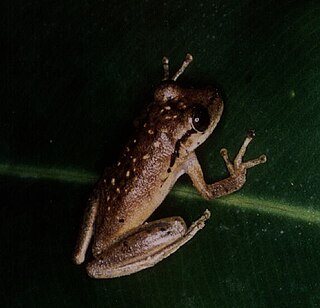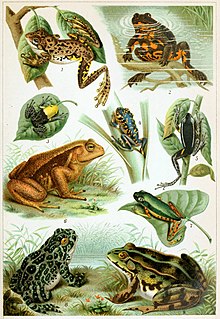
Scinax acuminatus is a species of frog in the family Hylidae. It is found in Argentina, Bolivia, Brazil, Paraguay, and possibly Uruguay. Its natural habitats are moist savanna, subtropical or tropical moist shrubland, subtropical or tropical seasonally wet or flooded lowland grassland, freshwater lakes, intermittent freshwater lakes, freshwater marshes, intermittent freshwater marshes, pastureland, rural gardens, heavily degraded former forest, ponds, and canals and ditches. It breeds in bodies of water. It is threatened by eventual habitat loss, but the population is currently fairly stable, as it adapts fairly well to human encroachment and development.
Scinax aromothyella is a species of frog in the family Hylidae.
Scinax auratus is a species of frog in the family Hylidae. It is endemic to Brazil. Its natural habitats are subtropical or tropical moist lowland forests, subtropical or tropical moist shrubland, freshwater marshes, intermittent freshwater marshes, rocky areas, and heavily degraded former forest. It is threatened by habitat loss.
Scinax baumgardneri is a species of frog in the family Hylidae. It is endemic to Venezuela. Its natural habitats are subtropical or tropical moist lowland forests and intermittent freshwater marshes. It is threatened by habitat loss.

Scinax boesemani is a species of frog in the family Hylidae. It is found in Brazil, French Guiana, Guyana, Suriname, Venezuela, possibly Bolivia, possibly Colombia, and possibly Peru. Its natural habitats are subtropical or tropical moist lowland forests and intermittent freshwater marshes. It is threatened by habitat loss.

Scinax carnevallii is a species of frogs in the family Hylidae.
Scinax centralis is a species of frog in the family Hylidae. It is endemic to Brazil. Its natural habitats are subtropical or tropical dry forests, moist savanna, subtropical or tropical moist shrubland, rivers, and intermittent freshwater marshes. It is threatened by habitat loss.
Scinax chiquitanus is a species of frog in the family Hylidae. It is found in Bolivia, Peru, and possibly Brazil. Its natural habitats are subtropical or tropical moist lowland forests and intermittent freshwater marshes. It is threatened by habitat loss.
Scinax constrictus is a species of frog in the family Hylidae.
Scinax humilis is a species of frog in the family Hylidae. It is endemic to Brazil. Its natural habitats are subtropical or tropical moist lowland forests, subtropical or tropical moist montane forests, swamps, intermittent freshwater marshes, and heavily degraded former forest. It is threatened by habitat loss.
Scinax ictericus is a species of frog in the family Hylidae. It is found in Colombia, Peru, possibly Bolivia, and possibly Brazil. Its natural habitats are subtropical or tropical moist lowland forests and intermittent freshwater marshes. It is threatened by habitat loss.
Scinax jureia is a species of frog in the family Hylidae. It is endemic to Brazil. Its natural habitats are subtropical or tropical moist lowland forests and intermittent freshwater marshes. It is threatened by habitat loss. It takes its name from the Juréia Massif in the Juréia-Itatins Ecological Station, where it has been found.
Scinax karenanneae is a species of frog in the family Hylidae. It is endemic to Colombia. Its natural habitats are subtropical or tropical moist lowland forests, rivers, freshwater marshes, and intermittent freshwater marshes. It is threatened by habitat loss.
Scinax kennedyi is a species of frog in the family Hylidae. It is found in Colombia and Venezuela. Its natural habitats are moist savanna, subtropical or tropical dry lowland grassland, subtropical or tropical seasonally wet or flooded lowland grassland, freshwater marshes, intermittent freshwater marshes, freshwater springs, and pastureland. It is threatened by habitat loss.
Scinax lindsayi is a species of frog in the family Hylidae. It is found in Brazil, Colombia, and possibly Venezuela. Its natural habitats are subtropical or tropical moist lowland forests and intermittent freshwater marshes. It is threatened by habitat loss.
Scinax littoralis is a species of frog in the family Hylidae. It is endemic to Brazil. Its natural habitats are subtropical or tropical moist lowland forests and intermittent freshwater marshes. It is threatened by habitat loss.
Scinax maracaya is a species of frog in the family Hylidae. It is endemic to Brazil. Its natural habitats are moist savanna, freshwater marshes, and intermittent freshwater marshes. It is threatened by habitat loss.
Scinax nebulosus is a species of frog in the family Hylidae. It is found in Bolivia, Brazil, French Guiana, Guyana, Suriname, and Venezuela. Its natural habitats are subtropical or tropical moist lowland forests, moist savanna, intermittent freshwater marshes, pastureland, rural gardens, and heavily degraded former forest. It is threatened by habitat loss.
Scinax pachycrus is a species of frog in the family Hylidae. It is endemic to Brazil. Its natural habitats are dry savanna, subtropical or tropical dry shrubland, subtropical or tropical dry lowland grassland, intermittent freshwater marshes, rocky areas, arable land, pastureland, and ponds. It is threatened by habitat loss.
Scinax pinima is a species of frog in the family Hylidae. It is endemic to Brazil. Its natural habitats are moist savanna, subtropical or tropical moist shrubland, subtropical or tropical high-altitude shrubland, subtropical or tropical dry lowland grassland, swamps, and intermittent freshwater marshes. It is threatened by habitat loss.






